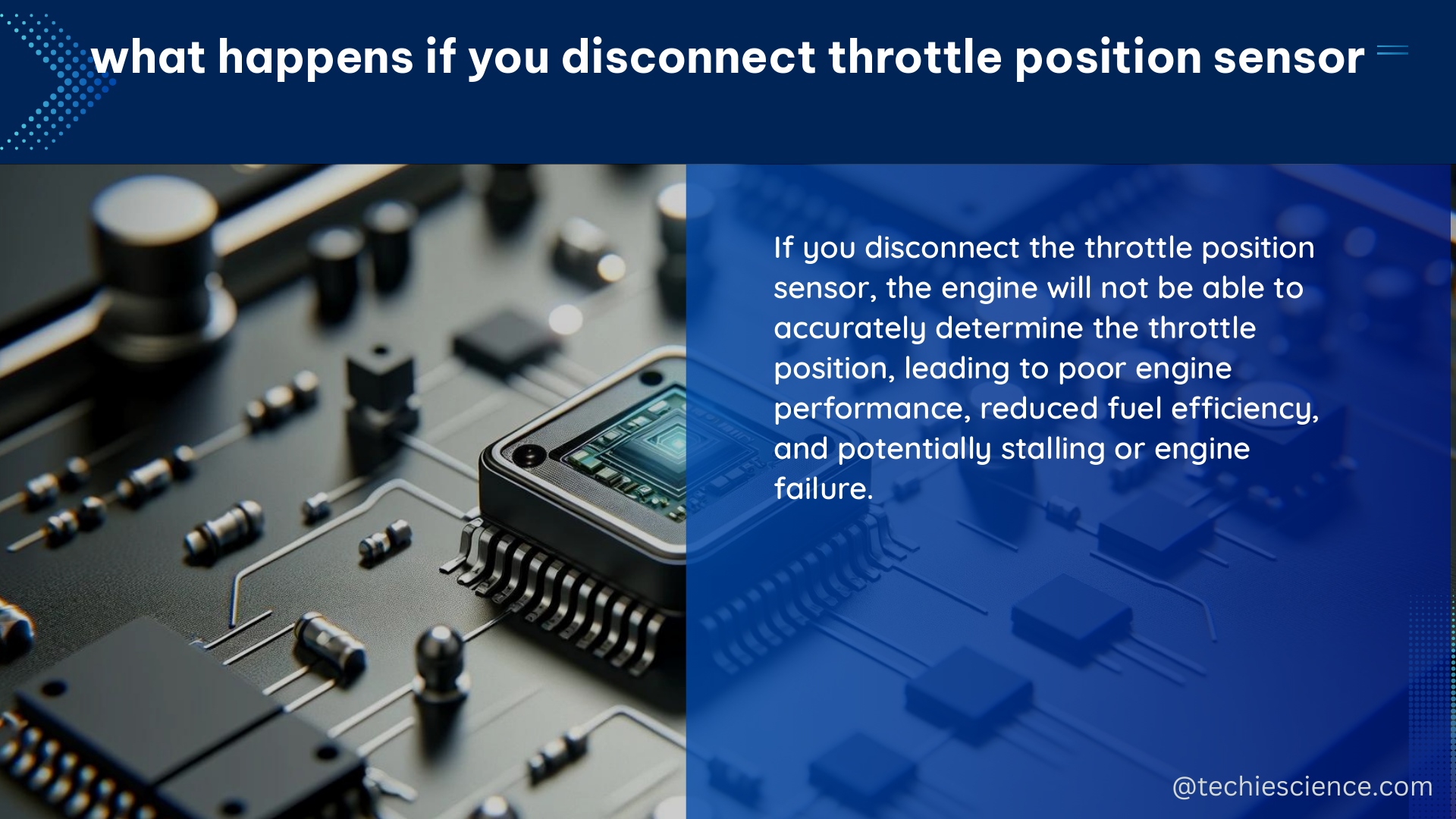Disconnecting the throttle position sensor (TPS) can have severe consequences on your vehicle’s engine performance, fuel efficiency, and overall drivability. This comprehensive guide will delve into the technical details of what happens when you disconnect the TPS, providing you with a thorough understanding of the potential issues and the steps you can take to address them.
The Importance of the Throttle Position Sensor
The throttle position sensor is a critical component in your vehicle’s engine management system. It is responsible for providing the Engine Control Module (ECM) or Engine Control Unit (ECU) with accurate information about the position of the throttle valve. This data is essential for the ECM/ECU to optimize the air-fuel mixture, ignition timing, and other engine parameters, ensuring efficient and smooth operation.
The Consequences of Disconnecting the Throttle Position Sensor

When you disconnect the throttle position sensor, the ECM/ECU loses the ability to accurately monitor the throttle valve position. This can lead to a cascade of issues that can significantly impact your vehicle’s performance and drivability.
1. Poor Engine Performance
Without the TPS data, the ECM/ECU cannot precisely control the air-fuel mixture and ignition timing. This can result in various performance issues, such as:
- Stalling: The engine may stall due to an incorrect air-fuel ratio or improper ignition timing.
- Hesitation: The engine may hesitate or stumble during acceleration, making the vehicle feel unresponsive.
- Rough Idling: The engine may idle roughly, with noticeable vibrations or fluctuations in RPM.
- Surging: The engine may experience sudden, uncontrolled increases in RPM, leading to a jerky driving experience.
2. Loss of Power and Reduced Fuel Efficiency
To protect the engine from potential damage, the ECM/ECU may default to a conservative or “limp-home” mode when the TPS is disconnected. This mode typically reduces engine power output and limits the vehicle’s top speed. As a result, you may experience:
- Sluggish Acceleration: The vehicle’s acceleration will be significantly reduced, making it challenging to merge or pass other vehicles.
- Decreased Fuel Efficiency: Without the ability to optimize the air-fuel mixture, the engine’s fuel consumption will increase, leading to a drop in miles per gallon (MPG) or liters per 100 kilometers (L/100 km).
3. Diagnostic Trouble Codes and Check Engine Light
When the TPS is disconnected, the ECM/ECU will detect the issue and store a diagnostic trouble code (DTC) related to the TPS circuit. This will typically cause the Check Engine Light (CEL) to illuminate on your vehicle’s dashboard, alerting you to the problem.
4. Potential Engine Damage
In some cases, prolonged operation with a disconnected TPS can lead to engine damage. The ECM/ECU’s inability to accurately control the air-fuel mixture and ignition timing can result in conditions that can harm engine components, such as:
- Increased Risk of Knocking or Pinging: Without proper ignition timing, the engine may experience knocking or pinging, which can lead to damage to the pistons, rings, and other internal components.
- Increased Cylinder Temperatures: An incorrect air-fuel mixture can result in higher cylinder temperatures, potentially leading to premature wear or failure of the engine’s valves, piston rings, and other critical components.
Diagnosing and Resolving TPS-Related Issues
If you suspect a problem with your vehicle’s throttle position sensor, it’s essential to take the following steps to diagnose and resolve the issue:
-
Retrieve Diagnostic Trouble Codes: Use an OBD-II scanner to read the diagnostic trouble codes stored in the ECM/ECU. This will provide you with specific information about the TPS-related problem.
-
Inspect the TPS: Visually inspect the throttle position sensor for any signs of damage, dirt, or debris. Clean the sensor according to the manufacturer’s recommendations, if necessary.
-
Test the TPS: Use a multimeter to measure the TPS’s resistance and ensure it falls within the specified range for your vehicle. This will help you determine if the sensor is functioning correctly.
-
Replace the TPS: If the TPS is faulty or outside the acceptable range, you will need to replace it. Always use a high-quality replacement part that meets or exceeds the original equipment manufacturer (OEM) specifications.
-
Clear Diagnostic Trouble Codes: After replacing the TPS, use the OBD-II scanner to clear the diagnostic trouble codes and verify that the issue has been resolved.
Remember, if you are not comfortable performing these diagnostic and repair steps, it’s best to consult a professional mechanic to ensure the problem is properly addressed and to avoid any potential damage to your vehicle.
Conclusion
Disconnecting the throttle position sensor can have severe consequences on your vehicle’s engine performance, fuel efficiency, and overall drivability. By understanding the technical details and the potential issues that can arise, you can make an informed decision about whether to attempt a DIY repair or seek the assistance of a professional mechanic. Proper diagnosis and repair of TPS-related issues are crucial to maintaining the health and performance of your vehicle.
References
- What Happens If You Disconnect Throttle Position Sensor?
- What Happens If You Disconnect Your Car’s Throttle Position Sensor?
- What Happens If You Disconnect Your Car’s Throttle Position Sensor?

The lambdageeks.com Core SME Team is a group of experienced subject matter experts from diverse scientific and technical fields including Physics, Chemistry, Technology,Electronics & Electrical Engineering, Automotive, Mechanical Engineering. Our team collaborates to create high-quality, well-researched articles on a wide range of science and technology topics for the lambdageeks.com website.
All Our Senior SME are having more than 7 Years of experience in the respective fields . They are either Working Industry Professionals or assocaited With different Universities. Refer Our Authors Page to get to know About our Core SMEs.